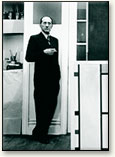Broadway Boogie Woogie

The Dutch artist Piet Mondrian (1872-1944) was a pioneer in “abstraction.” Each painting was worked and reworked, built layer by layer toward an equilibrium of form, color and surface.
Born in Holland in 1878, Piet Mondrian painted traditional subjects in an increasingly abstract style. By 1920, he adopts a totally abstract motif, employing an irregular checkerboard drawn with black lines, and with the spaces paints mostly white or sometimes in the primary colors of blue, red and yellow.

This is typical of about 250 abstract paintings dating from 1917 to 1944. Mondrian named his style “neoplasticism,” his translation of his own Dutch phrase nieuwe beelding, which also means “new form” or “new image.”
Escaping in 1940 from a Europe at war, Mondrian spends the last four years of his life in New York City, where he is fascinated by the exuberance of its city life. His paintings of that time express that exuberance. In his final painting, Broadway Boogie Woogie (1942-1943), below, the checkerboard lines, previously black, are now painted blue, gray, red and yellow. (The yellow was apparently inspired by New York’s Yellow cabs).
In Broadway Boogie Woogie, Mondrian represents the restless motion of the city. Move the button underneath the painting from right to left to remove the hue (color), without altering the luminance (brightness).
As you move the pink knob above, what disappears? The yellow and gray areas (gray squares), easily distinguished in the colored image, cannot be distinguished in the black-and-white image. Thus, the yellow and gray areas have been painted with the same luminance (brightness).
We distinguish adjacent objects if they have different levels of brightness. Our brains cannot position the yellow and gray areas accurately in the painting because they have the same brightness. That is the origin of the jittery motion we seem to see in the painting. This effect has been used by many artists, including Pierre-Auguste Renoir and Claude Monet. These qualities are particularly admired by Bridget Riley.